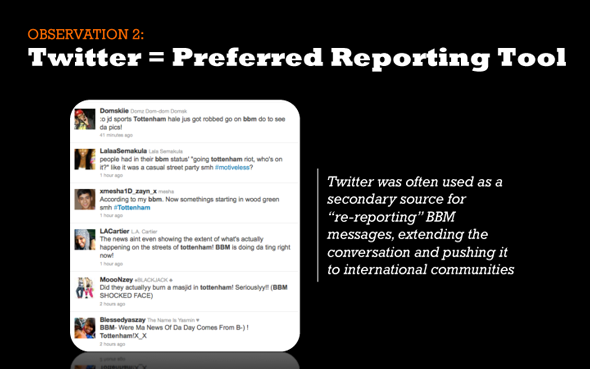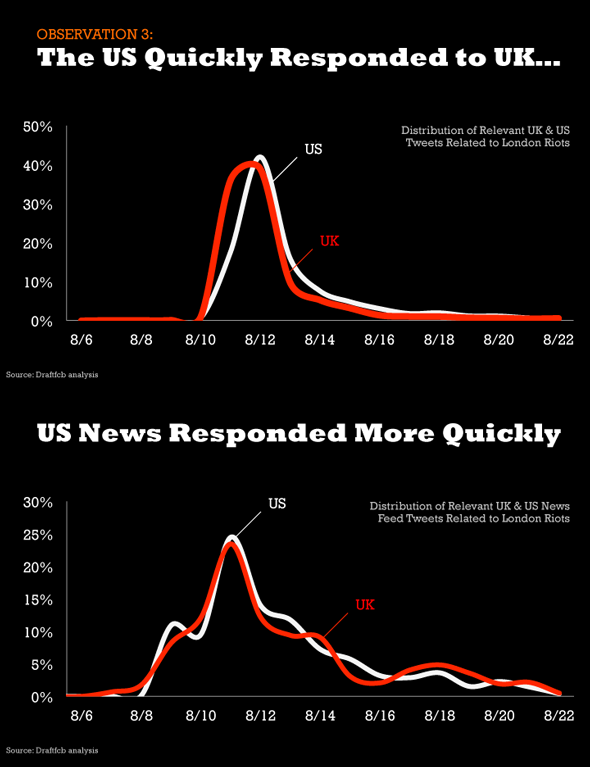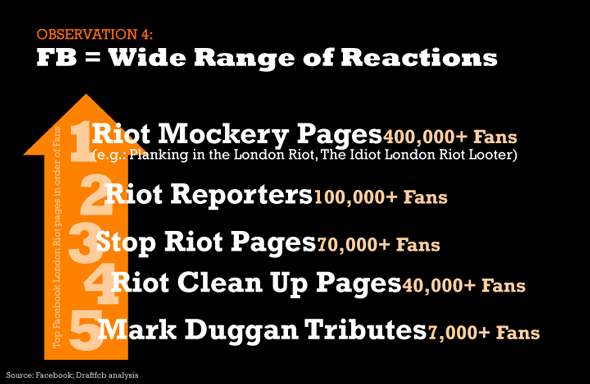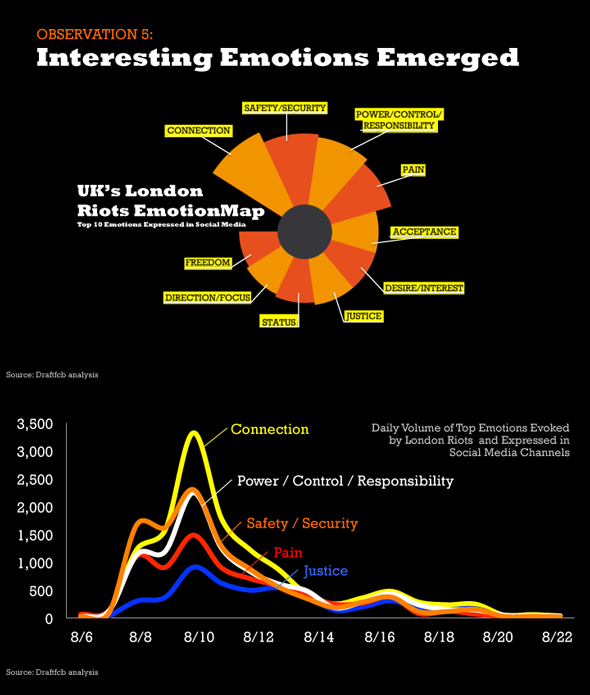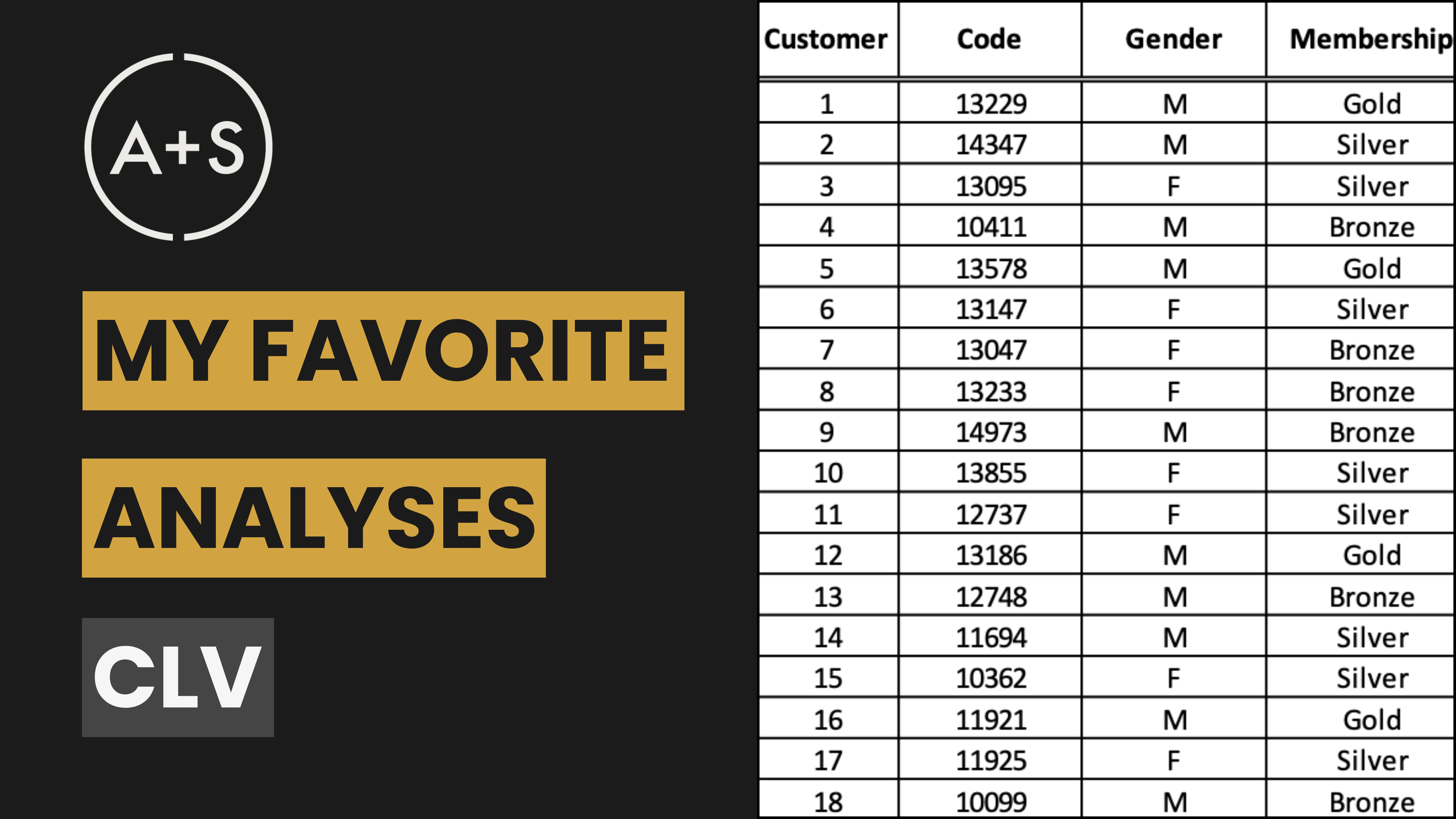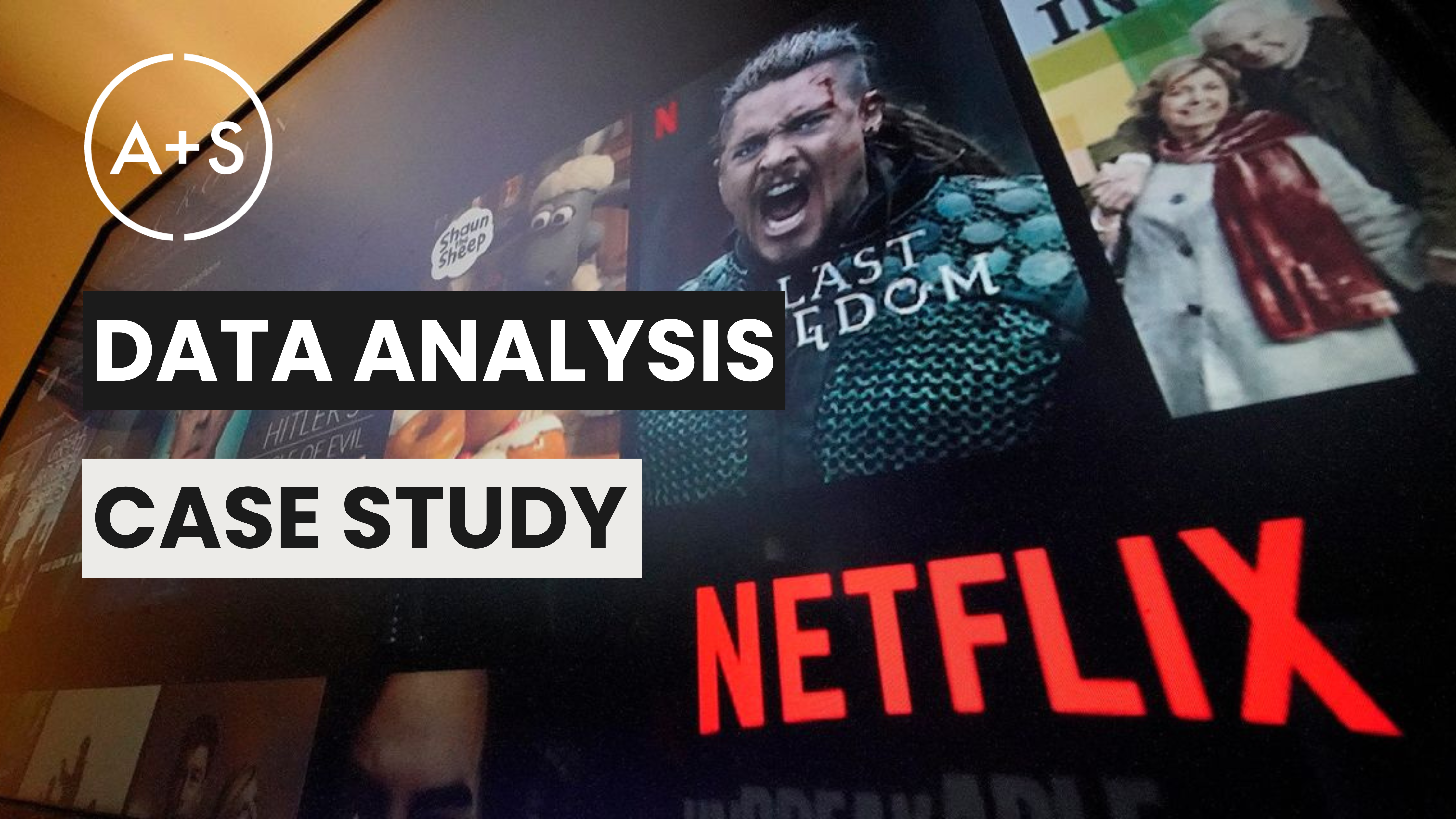In 1985 London boiled in a summer of unrest known as the Broadwater Farm Riots. Some 26 years later, last summer’s London Riots began under much the same circumstances yet grew to be dramatically more destructive.
The primary difference between the two events: the present-day existence of social media.
As a result the London Riots of 2011 were meticulously documented in millions of Tweets, BBM messages, Internet news mentions, and Facebook posts. The electronic record tells a fascinating tale of social media’s role in the chaos, from its provision of “utilities” for riot planners and onlookers to its ability to steer the event’s emotional tone.
Framed in the context of the Arab Spring uprising that came before and the Occupy Movement that would follow, this presentation offers a unique view into one of the most devastating illustrations of social media’s power the world has known and the role it plays for revolutionaries, rioters, and rebels alike.
Click HERE to download a copy of the presentation from 2012’s SXSWi festival.
The electronic record of the 2011 London Riots tells a fascinating tale of the power and effectiveness of social media
The march began peacefully enough. Just a few days before, what started as a routine encounter with Metropolitan Police quickly and tragically unraveled resulting in the death of a London citizen. Now on this day in Tottenham, mourning friends and family are joined by hundreds of supporters, many who harbor suspicions that London police systematically discriminate against minorities as surely as their use of aggression and intimidation had grown out of control.
And just as that fateful encounter with police had turned, this somber, peaceful demonstration quickly and tragically descends into a dark and violent expression of frustrations that have been mounting for years. The event sparks a calamitous string of riots, fueled by high levels of youth unemployment and a smoldering discontent with the current English government. The year is 1985.
Twenty-six years ago the death of Cynthia Jarrett and the subsequent Broadwater Farm Riots in London’s north very much mirrored the events surrounding this summer¹s devastating London Riots. But what began on 4 August 2011 with the shooting death of Mark Duggan at the hands of Metropolitan Police and — in a chilling re-telling of history — exploded into violence during an initially peaceful march in Tottenham. It was in one way very different from the events of 1985: this summer’s unrest was meticulously documented in literally millions of Tweets, BBM messages, Internet news mentions, and Facebook posts. And the electronic record of the 2011 London Riots tells a fascinating tale of the power and effectiveness of social media.
What follows are five observations on the role social media played in the London Riots born from an analysis of data earned from Twitter, Facebook, various online news feeds, a host of chat services / blogs, and Blackberry’s BBM messaging service.
Blackberry Messager was the safest tool rioters could use for planning their moves
Social media channels quickly became the obvious and most effective means for rioters and riot observers to communicate during the chaotic days following the Mark Duggan Justice Walk. The channels offered instantaneous connections to great numbers of engaged and passive populations in and around London. Significantly, they also offered the easiest path to international communities.
BBM, Blackberry’s free Internet-based instant messaging service, played a primary role in the planning and execution of much of the city’s unrest. As the smartphone of choice of London youth, Blackberry enjoys a considerable chunk of the UK’s communication market. BBM connects these Blackberry owners to one another instantly and allows for a single message to be broadcast to large audiences.
But what made BBM critical during the London Riot was the fact that the channel is untraceable. Indeed, Rioters learned from past international events, such as the Spring Arab Uprising, that authorities could track Twitter and other social media channels. As Scotland Yard monitored Twitter for signs of unrest, London rioters secreted messages to one another through BBMs. BBMs became the perfect communication “utility” for riot planners and participants.
Twitter was the reporting tool of choice
While rioters were BBMing covert plans to one another, the rest of the engaged world was receiving a blow-by-blow account of the London Riots through Twitter. Reports of new sites of unrest, first-hand accounts of the riot’s destruction, and unfiltered reactions to the events were broadcast throughout the tumultuous days in a thick stream of terse messages.
Frequently, Twitter was used to push BBMs to the audience outside Blackberry’s instant messaging system – as Twitter users literally copied and pasted BBM messages they received into Tweets – extending the life and reach of the communications.
Tweets of the riots quickly blasted outside the UK, flashing across the world to Twitter users in the US, Asia, mainland Europe, and elsewhere thereby enabling an international audience to partake in the London Riot conversation.
The US people responded quickly, but the US News responded even more quickly
Among international communities, the United States had one of the largest responses to Tweets rolling out of the UK. Tweets (and Re-Tweets) from US citizens closely and quickly mirrored the riot-related messages originating in the UK.
Although the US Twitter traffic peaked slightly later than traffic in the UK, it did so in a more pronounced manner.
But perhaps more interesting was the response of US news media outlets. While stories of the London Riots were most certainly broke by UK news media, the US news machine quickly and fervently picked up those stories and distributed them to their followers through instant messages, Internet-based newsfeeds, and Tweets of their own. For the US news media, the London Riots became a more intense story than the more sustained and balanced coverage the riots received in the UK. Perhaps such attention from the US was the result of a slow domestic news desk or, more likely, American news outlets’ preoccupation with schadenfreude.
One thing that is certain is that as news of the riots intensified, expanded to international markets, and earned greater levels of social media attention so too did the draw for looters and riot participants. In this way, the scale and scope of the London Riot was extended.
Facebook featured a broad range of reactions to the riots
While instant messaging proved to be the preferred source of information-sharing around the London Riots, Facebook played an important role in the expression of reactions to the unrest, as well as the circumstances surrounding the event. London Riot Facebook pages quickly shot up, including pages devoted to reporting riot activity, pleas for Londoners to band together to stop and clean up the riot’s devastation, and tribute pages to the riot’s principal martyr, Mark Duggan.
But in terms of Facebook Fans, the most influential and valued pages where those dedicated to mocking the riot’s events. And by a wide margin, as riot mockery pages garnered Fans at a rate four-times faster than the next most popular category of riot-devoted pages. The examples offer insight into Londoner’s thoughts on the riot and rioters alike: nearly 150,000 people became Facebook Fans of “The Idiot London Riot Looter”, a page which cleverly exposed the idiocy of many London teens who perpetrated crimes and acts of violence during the unrest; “Planking in the London Riot” earned over 50,000 Fans, many contributing pictures of themselves familiarly lying prone among police in riot gear and burning shops.
The creation of these pages and their collection of Fans interestingly “democratized” reactions to the London Riots. It’s easy to consider Facebook pages outside the top five list presented above that resulted from the riots: pages devoted to fundraising, looter identification, victim’s stories. But while there were undoubtedly pages created in such categories, they failed to collect a high number of Facebook Fans. In this way Facebook became an open structure of “opinion quantification”, lending a numerical-based indication of people’s interests and response to the London Riots.
An interesting set of emotions emerged on social media during the riots
An analysis of the emotions expressed through social media channels during the London Riots reveals important insights into the tone and tenor of the unrest.
Among the top ten emotions voiced in instant messages, Tweets, Facebook posts, and other digital communications, emotions related to “connection” led the way while “freedom” logged in at number ten. To be sure, the riot in the UK were not fueled by the need to escape an oppressive government but rather a sense of unity for a common purpose. The emotional profile of the social media conversation makes sense in this context.
Yet several things about the emotional thumbprint of riot-related discussion remain unclear. Given the scale of the riots’ destruction, perhaps it was to be expected that concerns for safety and security would permeate the UK social media conversation. However, as the riots’ flashpoint was Mark Duggan’s death and the obvious distaste for London’s looters it is puzzling that expressions of “justice” were not more prominent.
Much more clear is how those emotions played out over the course of this summer’s events. August 10th marked the emotional highpoint for riot-related conversation – the same day, not coincidentally, that the riot reached its most violent and tumultuous point. Also interesting to note is that expressions of “pain”, “power / control / responsibility”, and “safety / security” hit an early peak just days into the riotous activity when the world was graphically introduced to the unrest. Conversely, “connection” peaked sharply on the riot’s darkest day, while “acceptance” slowly gained weight as the unrest wore on and the reality of London’s situation took hold. Taken together, these emotions provide a lasting, indelible cast of the London Riots’ emotion tone.
CONCLUSIONS
Social media channels – BBM, Twitter, Internet-based newsfeeds, Facebook, and others – played several prominent roles in the London Riots of 2011. Chief among them were social media’s part in…
· Providing communication “utilities”
· Enabling an international audience
· Extending riot’s scope and scale
· “Democratizing” reactions to the event
· Setting the event’s emotional tone
The cumulative effect of social media led to a summer of unrest in London that far eclipsed the Broadwater Farm Riot events some twenty-six years ago, despite the fact that each began in almost the same way and under a nearly identical set of circumstances.
A more devastating and awesome illustration of social media’s power may not soon be seen again.
I had a blast presenting “What The London Riots Taught Us About Social Media” today at SXSW. Even more fun than I had researching and writing the presentation. The audience was absolutely great, engaged and full of great questions after the show.
Click HERE to download a copy of the presentation from 2012’s SXSWi festival.



